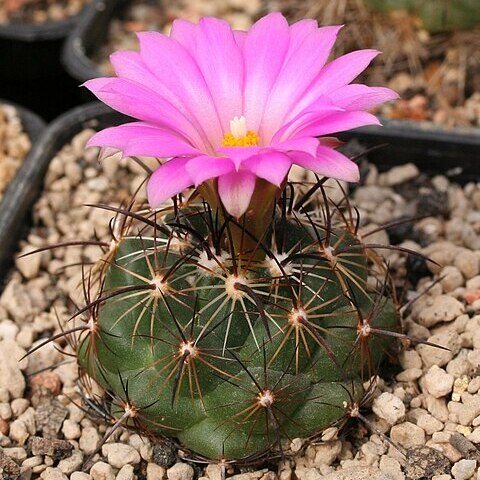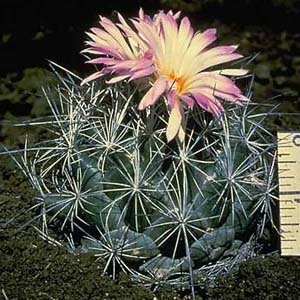Plants erect, spheric and unbranched or, if branched, then ultimately forming low clumps or small mats. Roots diffuse, succulent taproots (sometimes tuberlike or massive), or in some species ultimately adventitious from bases of branches. Stems unsegmented, hemispheric, spheric, ovoid, or cylindric, sometimes flat-topped, tuberculate, 1-20(-50) × 1-15 cm after sexual maturity; tubercles conic to hemispheric or cylindric, never coalescing into ribs, protruding conspicuously, grooved on their adaxial (upper) sides in sexually mature plants, i.e., areoles of sexually mature plants each consisting of fertile meristem (often woolly) in tubercle axil and spine cluster on tubercle apex, the two connected by a linear isthmus (areolar extension, often short woolly) recessed into an areolar groove on adaxial side of tubercle (groove extends only 1/2-3/4 distance from spine cluster to tubercle axil in C. macromeris); areolar glands present or absent; cortex and pith usually mucilaginous or with mucilage confined to flowers and fruits. Spines 3-95 per areole, color various, needlelike (peglike in C. minima), usually differentiated into radial and central spines; radial spines straight or curved; central spines, when present, straight or curved (hooked in C. robustispina), terete, 4-55 mm. Flowers diurnal (sometimes ± vespertine in C. tuberculosa), borne at or near stem apex (lateral in C. recurvata), on new growth of current year and/or last-produced areoles of preceding year (fruiting zone in some species becoming displaced outward and downward by apical vegetative growth after flowering), campanulate or funnelform to nearly salverform with recurved tepals, 1-6.5 × 0.6-10 cm; outer tepals entire or fringed; inner tepals variously colored, never pure red or blue, 4.5-40 × 1-15 mm, often glossy, margins entire, toothed, fringed, or erose; scales on ovary none or few, narrow or rudimentary, entire or erose, axils naked, spineless; stigma lobes 4-13, white to yellow or orange-yellow (rarely pinkish), 0.5-8 mm. Fruits indehiscent, green or red, spheric, ellipsoid, ovoid to narrowly fusiform, or obovoid, 1.5-50 × 1.5-20 mm, usually juicy, sometimes slimy or fleshy (dry in C. minima), scales usually absent (or few), spines absent; pulp colorless to white, greenish, or pinkish; floral remnant persistent or deciduous. Seeds usually reddish brown or black, sometimes yellowish, reniform, comma-shaped, obovoid, or spheric, 0.8-3.5 mm in greatest diam., shiny or glossy; testa smooth, raised-reticulate, or pitted; strophiole (unsclerified tissue in/around hilum) small or large, flat or slightly protruding, never surrounding micropyle, replaced by a narrow raphe in some species (e.g., C. ramillosa); sclerified collar between hilum and micropyle short, solid or grooved, nearly open in some species. x = 11.
More
Stems cylindric to globose, solitary or forming clumps, not jointed, covered with cylindric to conic tubercles, each of these with a terminal areole bearing radial and usually also central spines but lacking glochids; fls arising individually on new growth of the season at the base of an adaxial groove descending from the areole; hypanthium funnelform-prolonged above the ovary; fr thin-walled, fleshy; seeds small, dark, wingless. 30+, N. Amer.


